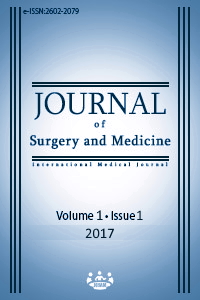Comparison of the Effects of Impaired Fasting Glucose and Impaired Glucose Tolerance on Diabetic Development Risks on HbA1c Levels: A Retrospective Study
Keywords:
Prediabetes, Impaired Fasting Glucose, Impaired Glucose ToleranceAbstract
Aim: The process between normal glucose metabolism and diabetes is called the prediabetic period. This period is impaired fasting glucose (IFG), impaired glucose tolerance (IGT) or glycosylated hemoglobin A1c (HbA1c) level of 5.7% -6.5%. IFG, IGT or IFG+IGT, shows increased risk of developing diabetes. The aim of this study is to compare the risk levels of diabetes development between glucose metabolism disorders.
Methods: Patients who underwent oral glucose tolerance test (OGTT) and whose HbA1c values were measured before and after the test on a quarterly basis and did not have diabetes in 2016, were scanned through the automation system and taken into study. Patients with HbA1c levels between 5.7 and 6.4% were evaluated as prediabetic and an increase in the HbA1c levels in these patients from 5.7% to 6.4% was considered to increase the risk of developing diabetes. Patients were divided into three groups according to the presence of isolated IFG, isolated IGT and IFG + IGT. Patients with IFG were group 1, patients with IGT were group 2, and patients with IFG + IGT were group 3. Correlation analysis was performed between the groups on HbA1c levels.
Analyzes were performed using the SPSS 22.0 program. Mann Whitney U Test was used for descriptive statistical methods as well as for non-normal distribution of measured values. Significance was evaluated at p <0.05.
Results: In the study period, 706 patients who had OGTT in our hospital and who had HbA1c levels before and after OGTT on a quarterly basis were determined. The number of patients in Group 1 was 272; in group 2 was 222 and in group 3 was 212. Compared to the HbaA1c levels of groups, the risk of diabetes development in Group 1 was statistically low compared to group 2 and 3 (p<0,001). No statistically significant differences were detected between group 2 and 3 (p=0,381).
Conclusions: As a result of our study, patients with isolated IGT and IFG+IGT were found to be significantly higher than patients with an isolated IFG of diabetes development risks. There was no apparent difference between those with an isolated IGT and the IFG+IGT.
Downloads
References
International Diabetes Fedaration, Diabetes Atlas 7th edition 2015.
Diabetes Mellitus ve Komplikasyonlarının Tanı, Tedavi ve İzlem Kılavuzu. Türkiye Endokrin ve Metabolizma Derneği. 2017.
American Diabetes Association. Standards Of Medical Care In Diabetes 2014. Diabetes Care. 2014;37(1):14-80
National Diabetes Data Group. Classification and Diagnosis of Diabetes and Other Categories Of Glukoz Intolerance. Diabetes 1979;28:1039-57.
WHO Study Group. Diabetes Mellitus. Technical Support Series 727. Geneva: World Healt Organization 1985.
Expert Committee on the Diagnosis and Classification of Diabetes Mellitus. Report of the Expert Committee on the Diagnosis and Classification of Diabetes Mellitus. Diabetes Care 1997;20:1183-97.
World Healt Organization. Definiton, Diagnosis and Classification of Diabetes Mellitus and Its Complications. Report of WHO Consultation. Part: Diagnosis, and Classification of Diabetes Mellitus: Geneva World Healt Organization 1999
Unwin N, Shaw J, Zimmet P, et al. Impaired Glucose Tolerance and Impaired Fasting Glycemia: The Current Status on Definition and İntervention. Diabetic Medicine 2002;19:708-23.
Tabák AG, Herder C, Rathmann W, Brunner EJ, Kivimäki M. Prediabetes: A High-risk State for Diabetes Development. Lancet. 2012;379(9833):2279-2290.
Aydın Y, Berker D, Güler S. Bozulmuş Açlık Glikozu, Bozulmuş Glikoz Tolerans ve Ateroskleroz. İç Hastalıkları Dergisi. 2007;14(2):98-104.
DeFronzo R.A, Abdul-Ghani A.A. Preservation of β Cell Function: The Key To Diabetes Prevention. J Clin Endocrinol Metab 2011;96(8):2354-2366.
Bergman M. Pathophysiology of Prediabetes and Treatment Implications For The Prevention of Type 2 Diabetes Mellitus. Endocrine 2013;43:504-513.
Perreault L, Faerch K. Approaching Pre-diabetes. Journal of Diabetes and its Complications 2014;28:226-233.
Salas-Salvado J, Bullo M, Babio N, et al. Reduction in The Incidence Of Type 2 Diabetes with The Mediterranean Diet: Results Of The Predimed-Reus Nutrition Intervention Randomized Trial. Diabetes Care 2011; 34:14.
Estruch R, Ros E, Salas-Salvado J. et al. Primary Prevention of Cardiovascular Disease with a Mediterranean Diet. N Engl J Med 2013;368:1279.
Helmrich SP, Ragland DR, Leung RW, Paffenbarger RS. Jr. Physical Activity and Reduced Occurence of Non-insulin Dependent Diabetes Mellitus. N Engl J Med. 1991;325:147.
Jeon CY, Lokken RP, Hu FB, van Dam RM. Physical Activity of Moderate Intensity and Risk of Type 2 Diabetes: A Systematic Review. Diabetes Care 2007;30:744.
Grontved A, Rimm EB, Willett WC, et al. A Prospective Study of Weight Training and Risk of Type 2 Diabetes Mellitus in Men. Arch Intern Med 2012;172:1306.
Gillet M, Royle P, Snaith A, et al. Non-Pharmacological Interventions to Reduce The Risk of Diabetes in People with İmpaired Glucose Regulation: A Systematic Review And Economic Evaluation. Health Technol Assess 2012;16:1.
Tuomilehto J, Lindström J, Eriksson JG, et al. Prevention of Type 2 Diabetes Mellitus by Changes in Lifestyle Among Subjects with Impaired Glucose Tolerans. N Engl J Med 2001;344:1343.
Pan XR, Li GW, Hu YH, et al. Effects of Diet and Exercise in Preventing NIDDM in People with Impaired Glucose Tolerance. The Da Qing IGT and Diabetes Study. Diabetes Care 1997;20:537-543.
Bansal N. Prediabetes Diagnosis and Treatment: A review. WJD 2015;2:297-300.
Downloads
- 5281 3345
Published
Issue
Section
How to Cite
License
Copyright (c) 2017 Abdülkadir Aydın, Yıldız Atadağ, Ahmet Öksüz, Didem Kaya, Nagehan Esra Aydın
This work is licensed under a Creative Commons Attribution-NonCommercial-NoDerivatives 4.0 International License.















